组织行为学精要第十版chapter16 organizational change
- 格式:ppt
- 大小:1.38 MB
- 文档页数:25
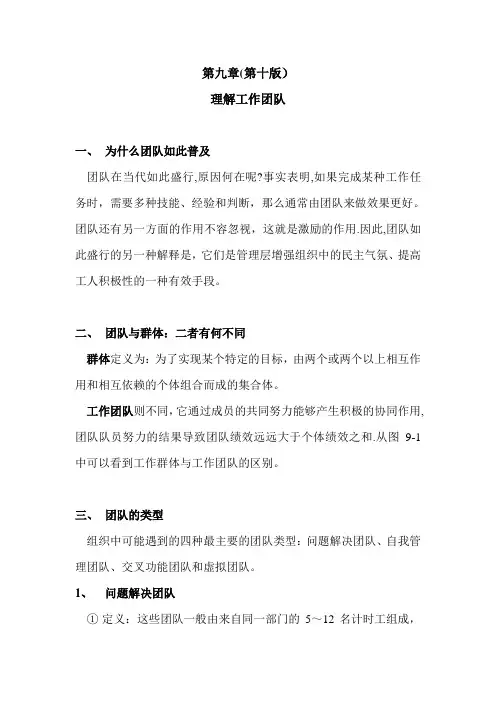
第九章(第十版)理解工作团队一、为什么团队如此普及团队在当代如此盛行,原因何在呢?事实表明,如果完成某种工作任务时,需要多种技能、经验和判断,那么通常由团队来做效果更好。
团队还有另一方面的作用不容忽视,这就是激励的作用.因此,团队如此盛行的另一种解释是,它们是管理层增强组织中的民主气氛、提高工人积极性的一种有效手段。
二、团队与群体:二者有何不同群体定义为:为了实现某个特定的目标,由两个或两个以上相互作用和相互依赖的个体组合而成的集合体。
工作团队则不同,它通过成员的共同努力能够产生积极的协同作用,团队队员努力的结果导致团队绩效远远大于个体绩效之和.从图9-1中可以看到工作群体与工作团队的区别。
三、团队的类型组织中可能遇到的四种最主要的团队类型:问题解决团队、自我管理团队、交叉功能团队和虚拟团队。
1、问题解决团队①定义:这些团队一般由来自同一部门的5~12名计时工组成,他们每周用几个小时的时间来会面,讨论如何促进产品质量、提高生产效率、改善工作环境等问题。
我们把这种团队称为问题解决团队。
②质量圈:他们定期会面,共同讨论质量问题、调查问题的起因、提出解决问题的建议,并采取纠正性的行动。
2、自我管理团队①定义:自我管理团队通常由10~15人组成,队员之间或者是工作业绩息息相关,或者是从事相互依赖性的工作。
他们承担了最多以前由主管承担的责任。
一般来说,他们的责任范围包括:计划和安排工作日程:给各成员分配工作任务;总体把握工作的步调;做出操作层面的决策;对出现问题采取措施以及与供货商和顾客打交道。
研究总体上表明,实施这种团队形式并不总能带来积极效果。
3、交叉功能团队①定义:这些团队由来自同一等级但不同工作领域的员工组成,他们为了完成一项任务而共同工作。
同样,由来及多个部门的成员组成的委员会是交叉功能团队的另一个例子。
②作用:交叉功能团队可以成为一种有效的方式,它使组织内部(甚至是组织之间)不同领域的员工交流信息,它激发人民采用新办法解决问题,并使人们共同合作完成复杂的项目。
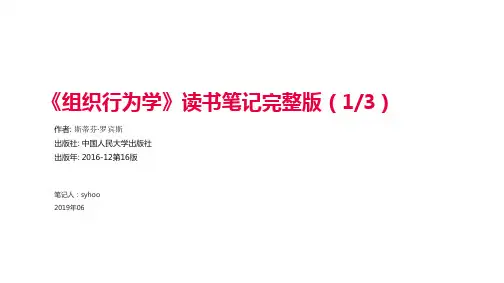
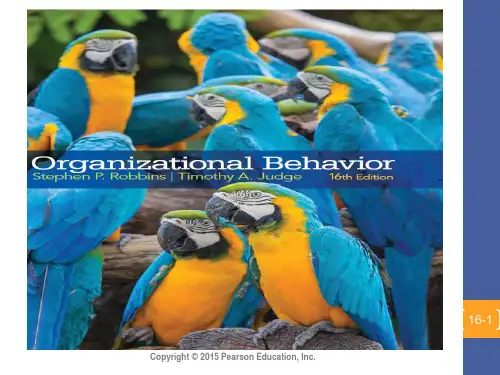
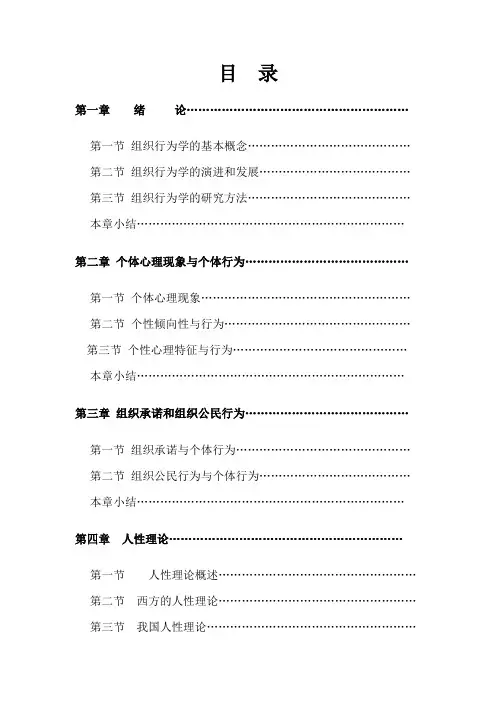
目录第一章绪论…………………………………………………第一节组织行为学的基本概念……………………………………第二节组织行为学的演进和发展…………………………………第三节组织行为学的研究方法……………………………………本章小结……………………………………………………………第二章个体心理现象与个体行为……………………………………第一节个体心理现象………………………………………………第二节个性倾向性与行为…………………………………………第三节个性心理特征与行为………………………………………本章小结……………………………………………………………第三章组织承诺和组织公民行为……………………………………第一节组织承诺与个体行为………………………………………第二节组织公民行为与个体行为…………………………………本章小结……………………………………………………………第四章人性理论……………………………………………………第一节人性理论概述……………………………………………第二节西方的人性理论……………………………………………第三节我国人性理论………………………………………………本章小结………………………………………………………………第五章群体心理、群体行为与群体绩效………………………………第一节群体概述……………………………………………………第二节非正式群体…………………………………………………第三节群体行为的一般规律……………………………………第四节影响群体心理、行为和绩效的主要因素…………………第五节群体决策……………………………………………………本章小结……………………………………………………………第六章组织中的人际关系…………………………………………第一节人际关系概述…………………………………………第二节人际关系的理论………………………………………第三节人际关系的平衡…………………………………………第四节人际关系的测量………………………………………本章小结…………………………………………………………第七章激励理论……………………………………………………第一节激励概述………………………………………第二节内容型激励理论……………………………………第三节过程型激励理论………………………………………第四节行为改造型激励理论…………………………………第五节激励理论与文化背景……………………………………本章小结…………………………………………………………第八章组织文化与组织行为……………………………………第一节组织文化的内涵………………………………………第二节组织文化的功能及影响因素…………………………第三节组织文化建设…………………………………………本章小结……………………………………………………………第九章领导的心理与组织行为……………………………………第一节领导及领导的影响力……………………………………第二节领导的有效性理论………………………………………第三节领导的有效性……………………………………………本章小结…………………………………………………………第十章组织行为的有效性…………………………………………第一节组织概述………………………………………………第二节组织结构………………………………………………第三节对组织变革的有效管理………………………………第四节组织发展………………………………………………本章小结…………………………………………………………参考文献。

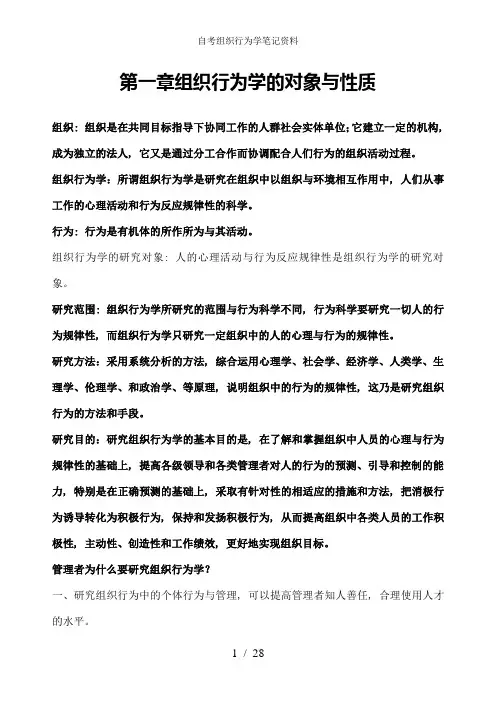
第一章组织行为学的对象与性质组织: 组织是在共同目标指导下协同工作的人群社会实体单位;它建立一定的机构, 成为独立的法人, 它又是通过分工合作而协调配合人们行为的组织活动过程。
组织行为学:所谓组织行为学是研究在组织中以组织与环境相互作用中, 人们从事工作的心理活动和行为反应规律性的科学。
行为: 行为是有机体的所作所为与其活动。
组织行为学的研究对象: 人的心理活动与行为反应规律性是组织行为学的研究对象。
研究范围: 组织行为学所研究的范围与行为科学不同, 行为科学要研究一切人的行为规律性, 而组织行为学只研究一定组织中的人的心理与行为的规律性。
研究方法:采用系统分析的方法, 综合运用心理学、社会学、经济学、人类学、生理学、伦理学、和政治学、等原理, 说明组织中的行为的规律性, 这乃是研究组织行为的方法和手段。
研究目的:研究组织行为学的基本目的是, 在了解和掌握组织中人员的心理与行为规律性的基础上, 提高各级领导和各类管理者对人的行为的预测、引导和控制的能力, 特别是在正确预测的基础上, 采取有针对性的相适应的措施和方法, 把消极行为诱导转化为积极行为, 保持和发扬积极行为, 从而提高组织中各类人员的工作积极性, 主动性、创造性和工作绩效, 更好地实现组织目标。
管理者为什么要研究组织行为学?一、研究组织行为中的个体行为与管理, 可以提高管理者知人善任, 合理使用人才的水平。
二、研究组织行为中的群体行为与管理, 可以使管理者改善人际关系, 增强他们所管辖的群体的合理凝聚力和向心力。
三、研究组织行为中的领导行为与管理, 可以促使管理者提高领导素质, 改进领导行为, 掌握领导艺术, 增强领导的有效性。
四、研究组织行为中的激励理论与应用, 可以加强以人为中心的管理, 充分调动各方面的积极性、主动性和创造性。
五、研究组织行为学中的组织设计与组织变革的理论与方法, 可使管理者能更好地适应环境的变化, 进行组织是变革, 增强活力, 提高绩效。

组织行为学读书笔记组织行为学(Organizational Behavior,缩写为OB)是研究人在组织中的行为和个体、团队行为与组织的相互关系的学科。
它主要关注员工在工作环境中的行为、思维和情感,并研究这些因素如何影响组织的目标和效能。
组织行为学是一门涵盖多学科知识的领域,主要包括心理学、社会学、人力资源管理和商业管理等。
本文将通过对《组织行为学》一书的阅读和学习,对组织行为学这门学科进行系统总结和概述。
通过对该书内容的梳理和解读,我们能够更好地理解组织行为学的核心概念和理论,从而在实际工作和组织活动中运用这些概念和理论。
首先,书中提到组织行为学的核心概念之一是个体行为分析。
个体是组织行为学研究的基本单位,个体的行为对于组织的整体绩效和效能具有重要影响。
个体行为分析主要包括工作满意度、工作动机、工作压力等。
了解个体的行为特点和动机可以帮助管理者更好地调动员工的积极性和工作能力,提高组织绩效。
其次,团队行为分析也是组织行为学的重要领域。
团队作为组织的基本单元,团队的协作和协调能力对于组织的成功至关重要。
团队建设和团队领导是团队行为分析的重要内容,这包括如何建立高效的团队、如何激发团队成员的创造力和合作精神等。
通过深入研究团队行为,可以提高团队的工作效率和合作性,实现组织的目标。
另外,组织文化和组织变革也是组织行为学的重要方向。
组织文化是指组织中形成的一种共同的价值观、信念和行为规范,它对于组织成员的行为和决策起到重要的引导作用。
组织变革是指组织在面临外部环境变化时采取的适应性调整和改变。
通过研究组织文化和组织变革,可以帮助组织更好地应对变化和挑战,并保持竞争力。
在组织行为学的研究方法方面,书中介绍了定性和定量研究方法的应用。
定性研究方法主要通过访谈、观察和案例研究等方式收集和分析数据,主要用于深入理解个体和团队行为的本质和动因。
定量研究方法主要通过问卷调查、实验室实验和统计分析等方式收集和分析数据,主要用于验证和推广理论。
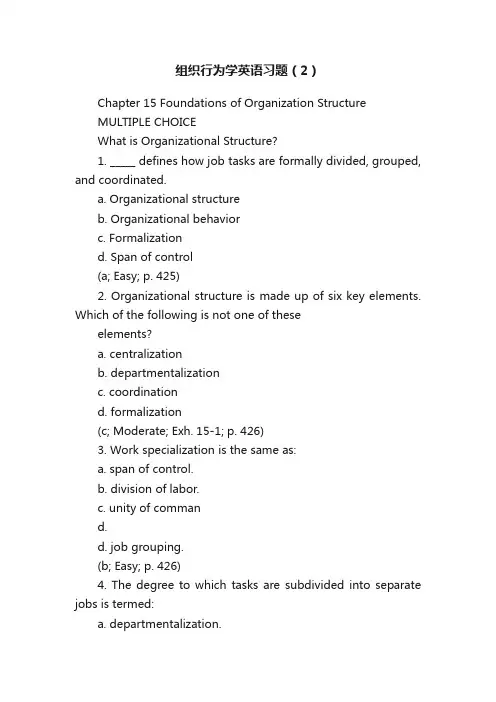
组织行为学英语习题(2)Chapter 15 Foundations of Organization StructureMULTIPLE CHOICEWhat is Organizational Structure?1. _____ defines how job tasks are formally divided, grouped, and coordinated.a. Organizational structureb. Organizational behaviorc. Formalizationd. Span of control(a; Easy; p. 425)2. Organizational structure is made up of six key elements. Which of the following is not one of theseelements?a. centralizationb. departmentalizationc. coordinationd. formalization(c; Moderate; Exh. 15-1; p. 426)3. Work specialization is the same as:a. span of control.b. division of labor.c. unity of command.d. job grouping.(b; Easy; p. 426)4. The degree to which tasks are subdivided into separate jobs is termed:a. departmentalization.c. work specialization.d. span of control.(c; Moderate; p. 426)5. In the late 1940s, most manufacturing jobs in industrialized countries were being done with high:a. departmentalization.b. formalization.c. work specialization.精品d. span of control.(c; Moderate; p. 426)6. For much of the first half of the 20th century, managers viewed _____ as an unending source ofincreased productivity.a. departmentalizationb. formalizationc. work specializationd. span of control(c; Moderate; p. 426)7. Which one of the following components of organizational structure specifically defines wheredecisions are made?a. complexityb. formalizationc. centralizationd. technology(c; Moderate; Exh 15-1; p. 426)8. The basis by which jobs are grouped together is termed:a. departmentalization.c. work specialization.d. centralization.(a; Easy; Exh. 15-1; p. 426)9. Grouping jobs on the basis of function, product, geography, process, or customer is a form of:a. departmentalization.b. work specialization.c. span of control.d. chain of command.(a; Moderate; p. 427)10. One of the most popular ways to group activities is by:a. product.b. function.c. geography.d. process.(b; Challenging; p. 427)精品11. Proctor & Gamble departmentalizes by Tide, Pampers, Charmin, and Pringles. This is an example ofdepartmentalization by:a. function.b. process.c. customer.d. product.(d; Easy; p. 428)12. A manufacturing manager who organizes the plant by separating engineering, accounting,manufacturing, personnel, and purchasing into departments is practicing _____ departmentalization.a. target customerb. productc. functionald. geographic(c; Moderate; p. 428)13. _____ departmentalization achieves economies of scale by placing people with common skills andorientations into common units.a. Functionalb. Processc. Productd. Geographic(a; Moderate; p. 428)14. At an Alcoa aluminum tubing plant in upstate New York, production is organized into fivedepartments: casting; press; tubing; finishing; and inspecting; packing; and shipping. This is an example of _____departmentalization.a. Functionalb. Processc. Productd. Geographic(b; Moderate; p. 428)15. The unbroken line of authority that extends from the top of the organization to the lowest echelonand clarifies who reports to whom is termed:a. chain of command.b. authority.精品c. power.d. unity of command.(a; Moderate; p. 429)16. The right inherent in a managerial position to give orders and expect orders to be obeyed is termed:a. chain of command.b. authority.c. power.d. unity of command.(b; Moderate; p. 429)17. The _____ principle helps preserve the concept of an unbroken line of authority.a. span of controlb. powerc. unity of commandd. decentralization(c; Moderate; p. 429)18. The _____ principle states that a person should have one and only one superior to whom he or she isdirectly responsible.a. span of controlb. chain of commandc. unity of commandd. power(c; Easy; p. 429)19. The _____ refers to the number of subordinates a manager can efficiently and effectively direct.a. span of controlb. unity of commandc. chain of commandd. organizational chart(a; Easy; p. 418)20. Which of the following is a drawback of a narrow span of control?a. It reduces effectiveness.b. It is more efficient.c. It encourages overly tight supervision and discourages employee autonomy.d. It empowers employees.精品(c; Challenging; p. 430)21. Which of the following is not a drawback of a narrow span of control?a.They are expensive.b.They make vertical communication in the organization more complex.c.They encourage employee autonomy.d.They encourage overly tight supervision.(c; Challenging; p. 430)22. The trend in recent years has been toward:a.narrower spans of control.b.wider spans of control.c. a span of control of five.d.an ideal span of control of eight.(b; Moderate; p. 430)23. If you have a narrow span of control, you have a _____ organization.a.multi-levelb.shortc.talld.matrix(c; Moderate; p. 430)24. _____ are consistent with recent efforts by companies to reduce costs, cut overhead, speed updecision making, increase flexibility, get closer to customers, and empower employees.a.Wider spans of controlb.Narrower spans of controlc.Flatter organizationsd.Formalization(a; Moderate; p. 430)25. The best definition for centralization is:a.decision discretion is pushed down to lower level employees.b.decision making is concentrated at a single point in the organization.c.decision making depends on the situation.d.decision making is done in each department and then sent to the president for the final decision. (b; Moderate; p. 431)26. The component of structure which considers where decision-making authority lies is:精品a. delegation.b. formalization.c. complexity.d. centralization.(d; Moderate; p. 431)27. In an organization that has high centralization:a. the corporate headquarters is located centrally to branch offices.b. all top level officials are located within the samegeographic area.c. top managers make all the decisions and lower level managers merely carry out topmanagement’s directions.d. action can be taken more quickly to solve problems.(c; Moderate; p. 431)28. The more that lower-level personnel provide input or are actually given the discretion to makedecisions, the more _____ there is.a. centralizationb. decentralizationc. work specializationd. departmentalization(b; Moderate; p. 431)29. If a job is highly formalized, it would not include which of the following?a. clearly defined procedures on work processesb. explicit job descriptionc. high employee job discretiond. a large number of organizational rules(c; Moderate; p. 431)30. Explicit job descriptions, lots of rules, and clearly defined procedures concerning work processes areconsistent with:a. high formalization.b. technological innovation.c. high centralization.d. an organic model.(a; Challenging; pp. 431-432)31. Employee discretion is inversely related to:a. complexity.精品b. standardization.c. centralization.d. technology.(b; Challenging; p. 432)Common Organizational Designs32. Which of the following is not a common organizational design?a.simple structureb.bureaucracyc.centralized structured.matrix structure(c; Easy; p. 433)33. The _____ is characterized by a low degree of departmentalization, wide spans of control, authority centralized in a single person, and little formalization.a. bureaucracyb. matrix organizationc. simple structured. team structure(c; Moderate; p. 433)34. Which one of the following is consistent with a simple structure?a. high centralizationb. high horizontal differentiationc. high formalizationd. high departmentalization(a; Moderate; p. 433)35. The ____ is a flat organization.a.simple structureb.bureaucracyc.centralized structured.matrix structure(a; Moderate; p. 433)36. Simple structures are characterized by:a. shared authority.精品b. a narrow span of control.c. lots of formalization.d. a low degree of departmentalization.(d; Moderate; p. 433)37. The ___ is most widely practiced in small businesses in which the manager and owner are one and thesame.a.simple structureb.bureaucracyc.centralized structured.matrix structure(a; Moderate; p. 433)38. The bureaucracy is characterized by all of the following except:a. highly routine operating tasks.b. formalized rules and regulations.c. tasks that are grouped into functional departments.d. decentralized decision making.(d; Moderate; p. 434)39. The key underlying all bureaucracies is:a. flexibility.b. standardization.c. dual lines of authority.d. wide span of control.(b; Moderate; p. 434)40. The ____ is characterized by highly routine operating tasks achieved through specialization.a.simple structureb.bureaucracyc.centralized structured.matrix structure(b; Moderate; p. 434)41. The strength of the simple structure lies in its:a.formalization.b.simplicity.精品c.centralization./doc/a912923417.html,rmation processing.(b; Easy; p. 433)42. Which of the following is not a weakness of the simple structure?a.It is risky./doc/a912923417.html,rmation overloadc.accountability is cleard.slower decision making(c; Moderate; p. 433)43. Specialization creates subunit conflicts in the:a.simple structure.b.bureaucracy.c.centralized structure.d.matrix structure.(b; Moderate; p. 434)44. The structure that creates dual lines of authority and combines functional and productdepartmentalization is the:a. simple structure.b. bureaucracy.c. matrix structure.d. virtual organization.(c; Moderate; p. 435)45. The matrix structure combines which two forms of departmentalization?a. simple and functionalb. functional and productc. product and organicd. organic and mechanistic(b; Challenging; p. 435)46. The _____ violates the unity of command concept.a. simple and functionalb. functional and productc. product and organicd. organic and mechanistic(c; Challenging; p. 435)精品47. Which one of the following problems is most likely to occur in a matrix structure?a. decreased response to environmental changeb. decreased employee motivationc. loss of economies of scaled. employees receiving conflicting directives(d; Moderate; p. 436)48. The strength of the matrix structure is its:a. ability to facilitate coordination.b. economies of scale.c. adherence to chain of command.d. predictability.(a; Moderate; p. 436)49. The major disadvantage of the matrix structure is:a. the confusion it creates.b. its propensity to foster power struggles.c. the stress it places on individuals.d. all of the above(d; Challenging; p. 436)New Design Options50. The primary characteristics of the _____ structure are that it breaks down departmental barriers anddecentralizes decision making to the level of the work team.a. virtual organizationb. teamc. boundarylessd. feminine organization(b; Moderate; p. 436)51. In larger organizations, the team structure complements what is typically a:a.virtual organization.b.bureaucracy.c.simple structure.d.boundaryless organization.(b; Challenging; p. 437)精品52. A small, core organization that outsources major business functions is the _____ organization.a. teamb. virtualc. boundarylessd. matrix(b; Moderate; p. 437)53. The ____ is also called the network or modular organization.a.virtual organizationb.team structurec.pyramidd.boundaryless organization(a; Moderate; p. 437)54. The prototype of the virtual structure is today’s:a.automobile manufacturers.b.movie-making organizations.c.fast-food restaurants.d.software companies.(b; Challenging; p. 437)55. The major advantage of the virtual organization is its:a. control.b. predictability.c. flexibility.d. empowerment.(c; Moderate; p. 438)56. The _____ organization stands in sharp contrast to the typical bureaucracy that has many verticallevels of management and where control is sought through ownership.a. virtualb. teamc. limitlessd. matrix(a; Challenging; p. 438)57. The boundaryless organization relies heavily on:/doc/a912923417.html,rmation technology.b.vertical boundaries.精品c.horizontal boundaries.d.external barriers.(a; Moderate; p. 438)58. An organization that seeks to eliminate the chain of command, have limitless spans of control, andreplace departments with empowered teams is the:a. virtual organization.b. boundaryless organization.c. matrix organization.d. team structure.(b; Moderate; p. 438)59. The one common technological thread that makes the boundaryless organization possible is:a. reengineering.b. MBA’s.c. networked computers.d. mainframes.(c; Moderate; p. 439)Why Do Structures Differ?60. The _____ is a structure characterized by extensivedepartmentalization, high formalization, a limitedinformation network, and centralization.a. mechanistic modelb. organic modelc. technology modeld. boundaryless organization(a; Moderate; p. 440)61. Which of the following is not a characteristic of a mechanistic structure?a. extensive departmentalizationb. high formalizationc. limited information networkd. flexibility(d; Easy; p. 440)62. If there is low formalization, a comprehensive information network, and high participation in decisionmaking, one would expect a(n):a. bureaucracy.精品b. mechanistic structure.c. organic structure.d. stable structure.(c; Challenging; p. 440)63. All of the following are characteristics of the organic model except:a. cross-functional teams.b. rigid departmentalization.c. cross hierarchical teams.d. free flow of information.(b; Moderate; p. 440)64. Which of the following is not a deter minant of an organization’s structure?a.strategy/doc/a912923417.html,anization sizec.industryd.technology(c; Moderate; pp. 440-444)65. Changes in corporate strategy precede and lead to:a. changes in the environment.b. better communication.c. increased productivity.d. changes in an organization’s structure.(d; Challenging; p. 440)66. A strategy that emphasizes the introduction of major new products and services is a(n) _____ strategy.a. innovationb. cost-minimizationc. imitationd. organic(a; Moderate; p. 441)67. The innovation strategy is characterized by:a. avoiding unnecessary costs.b. a mixture of loose with tight properties.c. low specialization and low formalization.d. tight controls over current activity.(c; Challenging; p. 441)精品68. _____ refers to how an organization transfers its inputsinto outputs.a.Imitationb.Technologyc.Operationsd.Innovation(b; Moderate; p. 441)69. Which of the following is not part of the organization’s environment?a.public pressure groupsb.customersc.technology/doc/a912923417.html,petitors(c; Easy; p. 443)70. The _____ of an environment refers to the degree to which it can support growth.a. capacityb. volatilityc. complexityd. nurturance(a; Moderate; p. 443)71. _____ refers to the degree of instability of an environment.a. Capacityb. Volatilityc. Complexityd. Equilibrium(b; Easy; p. 443)72. Three key dimensions to any organization’s environment have been found. Which of the following is not one of these key dimensions?a. volatilityb. capabilityc. complexityd. capacity(b; Moderate; p. 443)73. The _____ of an environment refers to the degree of heterogeneity and concentration amongenvironmental elements.a. capacity精品b. volatilityc. complexityd. creativity(c; Moderate; p. 443)Organization Designs and Employee Behavior74. Which of the following generalizations about organizational structures and employee performance and satisfaction is most true?a. There is fairly strong evidence linking decentralization and job satisfaction.b. It is probably safe to say that no evidence supports a relationship between span of control andemployee performance.c. The evidence generally indicates that work specialization contributes to lower employeeproductivity.d. No one wants work that makes minimal intellectual demands and is routine.(b; Challenging; pp. 445-446)75. _____ models of organizational structure are perceptionsthat people hold regarding structuralvariables formed by observing things around them in an unscientific fashion.a. Explicitb. Implicitc. Strategicd. Intuitive(b; Challenging; p. 447)TRUE/FALSE76. Organizations have different structures, but the structure has little bearing on employee attitudes andbehavior.(False; Easy; p. 425)What is Organizational Structure?77. Specialization defines how job tasks are formally defined, grouped, and coordinated.(False; Moderate; p. 426)78. Managers need to address six key elements when they design their organization’s structure: workspecialization, departmentalization, chain of command, span of control, centralization and decentralization, and formalization.(True; Moderate; p. 426)精品79. The degree to which tasks in the organization are subdivided into separate jobs is termeddepartmentalization.(False; Moderate; p. 426)80. Work specialization and division of labor are the same thing.(True; Easy; p. 426)81. Work specialization can be carried too far and may result in employee boredom, stress, andabsenteeism.(True; Moderate; p. 427)82. For much of the first half of this century, managers viewed departmentalization as an unendingsource of increased productivity.(False; Moderate; p. 427)83. The strength of functional departmentalization is putting similar specialists together.(True; Moderate; p. 428)84. Organizations may choose only one of the forms of departmentalization at a time.(False; Moderate; p. 429)85. The inherent right in a managerial position to give orders and expect the orders to be obeyed istermed authority.(True; Moderate; p. 429)86. Departmental ization answers questions for employee such as “To whom do I go if I have aproblem?”(False; Moderate; p. 429)87. The unbroken line of authority that extends from the top of the organization to the lowest echelon istermed the chain of command.(True; Easy; p. 429)88. The principle of unity of command suggests that managers should back one another up when adirective has been given.(False; Challenging; p. 429)89. The trend in recent years has been toward wider spans of control.(True; Easy; p. 430)90. Span of control determines the number of levels and managers an organization has.精品。
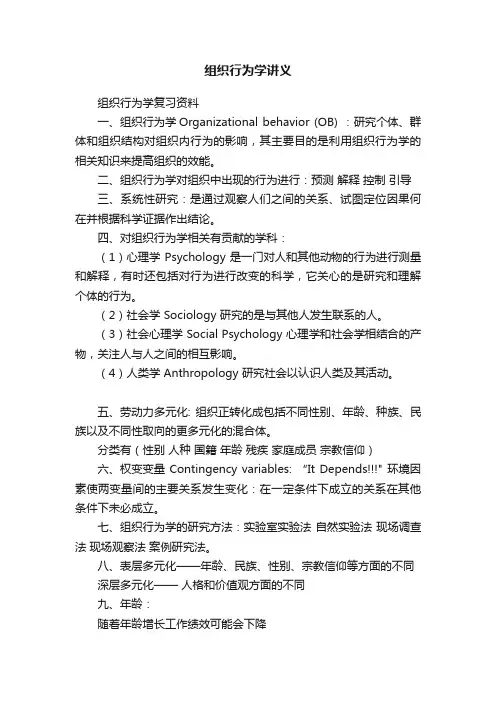
组织行为学讲义组织行为学复习资料一、组织行为学Organizational behavior (OB) :研究个体、群体和组织结构对组织内行为的影响,其主要目的是利用组织行为学的相关知识来提高组织的效能。
二、组织行为学对组织中出现的行为进行:预测解释控制引导三、系统性研究:是通过观察人们之间的关系、试图定位因果何在并根据科学证据作出结论。
四、对组织行为学相关有贡献的学科:(1)心理学 Psychology 是一门对人和其他动物的行为进行测量和解释,有时还包括对行为进行改变的科学,它关心的是研究和理解个体的行为。
(2)社会学 Sociology 研究的是与其他人发生联系的人。
(3)社会心理学 Social Psychology 心理学和社会学相结合的产物,关注人与人之间的相互影响。
(4)人类学 Anthropology 研究社会以认识人类及其活动。
五、劳动力多元化: 组织正转化成包括不同性别、年龄、种族、民族以及不同性取向的更多元化的混合体。
分类有(性别人种国籍年龄残疾家庭成员宗教信仰)六、权变变量Contingency variables: “It Depends" 环境因素使两变量间的主要关系发生变化:在一定条件下成立的关系在其他条件下未必成立。
七、组织行为学的研究方法:实验室实验法自然实验法现场调查法现场观察法案例研究法。
八、表层多元化——年龄、民族、性别、宗教信仰等方面的不同深层多元化——人格和价值观方面的不同九、年龄:随着年龄增长工作绩效可能会下降劳动力整体呈现老龄化强制退休年龄将不受法律保护年龄越大,离职的可能性就越小。
总的来说,年长的员工比年轻的员工在可避免的缺勤上比率更低,在不可避免的缺勤上,两者比率是一样的。
年龄与工作绩效没什么关系。
年长的员工对工作满意度更高对雇主承诺更高,呈U型关系。
十、性别Gender :在传统男性领域中成功的女性不受人喜欢、具有敌意,作为主管不被欢迎;全职妈妈更喜欢兼职工作、灵活的工作时间、远程办公;女性的缺勤率和离职率更高。
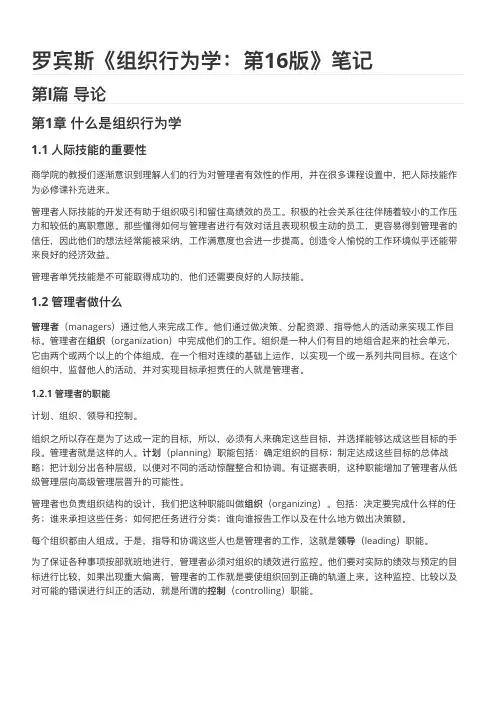
罗宾斯《组织⾏为学:第16版》笔记第Ⅰ篇导论第1章什么是组织⾏为学1.1 ⼈际技能的重要性商学院的教授们逐渐意识到理解⼈们的⾏为对管理者有效性的作⽤,并在很多课程设置中,把⼈际技能作为必修课补充进来。
管理者⼈际技能的开发还有助于组织吸引和留住⾼绩效的员⼯。
积极的社会关系往往伴随着较⼩的⼯作压⼒和较低的离职意愿。
那些懂得如何与管理者进⾏有效对话且表现积极主动的员⼯,更容易得到管理者的信任,因此他们的想法经常能被采纳,⼯作满意度也会进⼀步提⾼。
创造令⼈愉悦的⼯作环境似乎还能带来良好的经济效益。
管理者单凭技能是不可能取得成功的,他们还需要良好的⼈际技能。
1.2 管理者做什么管理者(managers)通过他⼈来完成⼯作。
他们通过做决策、分配资源、指导他⼈的活动来实现⼯作⽬标。
管理者在组织(organization)中完成他们的⼯作。
组织是⼀种⼈们有⽬的地组合起来的社会单元,它由两个或两个以上的个体组成,在⼀个相对连续的基础上运作,以实现⼀个或⼀系列共同⽬标。
在这个组织中,监督他⼈的活动,并对实现⽬标承担责任的⼈就是管理者。
1.2.1 管理者的职能计划、组织、领导和控制。
组织之所以存在是为了达成⼀定的⽬标,所以,必须有⼈来确定这些⽬标,并选择能够达成这些⽬标的⼿段。
管理者就是这样的⼈。
计划(planning)职能包括:确定组织的⽬标;制定达成这些⽬标的总体战略;把计划分出各种层级,以便对不同的活动惊醒整合和协调。
有证据表明,这种职能增加了管理者从低级管理层向⾼级管理层晋升的可能性。
管理者也负责组织结构的设计,我们把这种职能叫做组织(organizing)。
包括:决定要完成什么样的任务;谁来承担这些任务;如何把任务进⾏分类;谁向谁报告⼯作以及在什么地⽅做出决策额。
每个组织都由⼈组成。
于是,指导和协调这些⼈也是管理者的⼯作,这就是领导(leading)职能。
为了保证各种事项按部就班地进⾏,管理者必须对组织的绩效进⾏监控。
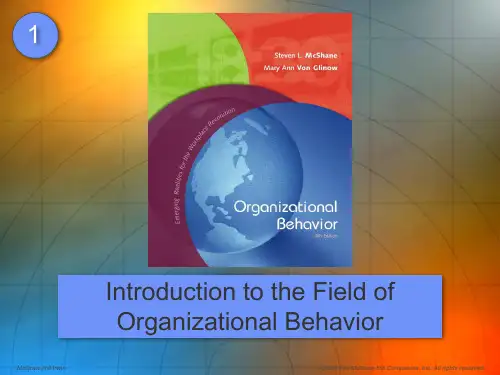
组织行为学经典教材以下是一些经典的组织行为学教材:1. 「组织行为学」(Organizational Behavior) by Stephen P. Robbins & Timothy A. Judge:这是一本广泛被使用的组织行为学教材,涵盖了各种组织行为学的基本概念和理论。
2. 「组织行为学导论」(Introduction to Organizational Behavior) by John R. Schermerhorn, Jr., Richard N. Osborn and Mary Uhl-Bien:该教材介绍了组织行为学的基本概念、理论和应用,并注重实践。
3. 「组织行为、领导力和变革管理」(Organizational Behavior, Leadership, and Change) by Gareth R. Jones and Jennifer M. George:该教材将组织行为学与领导力和变革管理相结合,通过实际案例和个案研究来展示相关理论和概念的应用。
4. 「组织行为学:识别和应对实践中的挑战」(Organizational Behavior: Managing People and Organizations) by Ricky W. Griffin and Gregory Moorhead:这本教材强调了组织行为学的应用,特别关注了人与组织的关系、团队动力和决策制定。
5. 「组织行为学:个体、团队和组织的行为和绩效」(Organizational Behavior: Improving Performance and Commitment in the Workplace) by Jason Colquitt, Jeffery LePine and Michael Wesson:该教材关注组织行为学在提高员工绩效和组织承诺方面的应用,通过案例研究和实践要点来强调关键概念和技能。
OrganizationBehavior组织⾏为学Organization BehaviorChapter1/doc/ad25610c4a7302768e9939d1.html anizational behavior (OB):A field of study that investigates the impact that individuals, groups and structure have on behavior within organization, for the purpose of applying such knowledge toward improving an organization’s effectiveness2. Managers doManagement functionPlanningA process that includes defining goals, establishingstrategy(策略), and developing plans to coordinate(调整)activitiesControllingMonitoring activities to ensure they are beingaccomplished as planned and correcting anysignificant deviations(背离).OrganizingDetermining what tasks are to be done, who is todo them, how the tasks are to be grouped, whoreports to whom, and where decisions are to bemade.LeadingA function that includes motivating employees,directing others, selecting the most effectivecommunication channels, and resolving conflictsManagement role: 1) interpersonal(⼈际⾓⾊)Figurehead(头⾯⼈物) Leader(领导者) Liaison(联络⼈)2) informational(信息传递者)Monitor(监控者) Disseminator(传递者) Spokesperson(发⾔⼈)3) Decisional(决策⾓⾊)Entrepreneur(创业者) Disturbance handler(混乱处理者)Resource allocator(资源分配者) Negotiator(谈判者)Management skills: 1) Technical skillsThe ability to apply specialized knowledge or expertise(专门技术).2) Human skillsThe ability to work with, understand, and motivate other people, both individually and in groups.3) Conceptual skillsThe mental ability to analyze and diagnose(诊断) complex situations. 3. Effective versus Successful Managerial Activities 1) Traditional managementDecision making, planning, and controlling2) CommunicationExchanging routine(例⾏的) information and processing paperwork3) Human resource managementMotivating, disciplining, managing conflict, staffing(⼈员指挥), and training4) NetworkingSocializing, politicking(政治活动), and interacting(相互影响) with others4. Challenges and Opportunities for OB1) Responding to GlobalizationIncreased foreign assignmentsWorking with people from different culturesOverseeing movement of jobs to countries with low-cost labor2) Managing Workforce Diversity(差异,多样性)Embracing diversityChanging demographics(⼈⼝)Implications for managersRecognizing and responding to differences3) Improving Quality and ProductivityQuality management (QM)Process reengineering4) Responding to the Labor ShortageChanging work force demographicsFewer skilled laborersEarly retirements and older workers5) Improving Customer ServiceIncreased expectation of service qualityCustomer-responsive cultures6) Improving People Skills7) Empowering(授权) People8) Stimulating(刺激) Innovation(改⾰) and Change9) Coping with “Temporariness(临时性)”10) Working in Networked Organizations11) Helping Employees Balance Work/Life Conflicts12) Improving Ethical(伦理的) Behavior5. Independent and dependent variables1) individual-level variables个体⽔平变量⼈们带着不同的特点进⼊组织,这些特点将影响到他们在⼯作中的⾏为。
第1章什么是组织行为学1.l 复习笔记一、管理者做什么管理者通过别人来完成工作,他们做出决策、分配资源、指导别人的活动从而实现工作目标。
1. 管理者的职能20世纪初,法国工业家亨利·法约尔(Henri Fayol)提出,所有的管理者都发挥五种职能:计划、组织、指挥、协调和控制。
今天这些职能简化为四种:计划、组织、领导和控制。
(1)计划计划活动就是要设定或明确组织的目标,制定实现组织目标的途径或方案。
(2)组织为了实现计划活动所预定的目标,实施计划活动制定的行动方案。
(3)领导管理者就运用各种适当的方法,去影响组织的成员,努力营造起一种使组织中的成员能够全心全意、士气高昂地为实现组织目标而努力奋斗的氛围,以便使管理的领导职能得到更大的发挥。
(4)控制为了确保组织目标的顺利实现,组织的管理者从头到尾地对组织各项活动的进展情况进行检查,一旦发现或预见问题后就要及时采取措施予以纠正,以保证组织活动按计划进行。
2. 管理者的角色20世纪60年代末,麻省理工学院(MIT)的研究生亨利·明茨伯格对5位高层经理进行了一项精心研究,明茨伯格得出结论:管理者扮演着10种不同的但又互相关联的角色。
这10种角色可以归纳为三大类:人际角色、信息传递者角色以及决策角色。
(1)人际关系方面的角色人际关系角色指所有的管理者都要履行礼仪性和象征性角色。
(2)信息传递方面的角色信息角色是指所有的管理者在某种程度上,都从外部的组织或机构接受和收集信息。
(3)决策制定方面的角色在决策角色中,管理者处理信息并得出结论。
亨利·明茨伯格界定的10种管理角色如表1.1所示。
3. 管理者的技能罗伯特·卡茨(Robert Katz)提出了三种基本的管理技能:技术技能、人际技能和概念技能。
(1)技术技能技术技能,指为了完成或理解一个组织的特定工作所必需的技能,也就是业务方面的技能。
(2)人际技能人际技能,指与组织单位中上下左右的人打交道的能力。